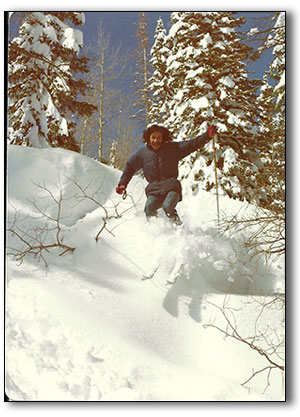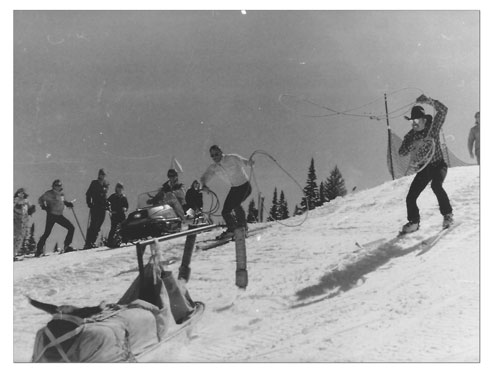
George Usinowicz (above) helped to digitize and catalogue the more than 1,000 images that are a part of the Purgatory Collection at Fort Lewis College’s Center of Southwest Studies./Photo by Jennaye Derge
Worth a thousand words
Purgatory calendar pics leave some guessing about who, when, where
by Tracy Chamberlin
Every year the calendar comes out with no captions necessary. Most people recognize the scenic shots of the Twilights at dusk or the panoramic view from the top of Lift 1. This year, however, the photographs aren’t so recognizable.
The 2016 Purgatory calendar is a collection of 13 photos, extending into January 2017. The images were selected from more than 1,000 gathered over the past couple of years for a special exhibit at the Center of Southwest Studies at Fort Lewis College. Known as the “Purgatory Collection,” those images were also used in the resort’s 50th anniversary book, Close to Heaven.
From the pioneers who made it all happen like Chet Anderson, who originally designed the area and became its first general manager, and Ray Duncan, the oilman who put his money where his passion was, to Purgatory’s current cast of leading characters, the collection tells the story of the ski area’s first 50 years with interviews, stories and photographs.
“Of all the resources that help us record, understand and appreciate our history, photographs may be the most important,” said Robert McDaniel, founding director of the Animas Museum and a ski patrolman at Purgatory for 38 years.
 |
| Usinowicz has been a part of Purgatory for more than 30 years, donning a simple parka and jeans in the winter of 1974-75 (bottom right) as he skis through trees at the resort. |
It all began when one retired Durangoan decided to go back to school.
George Usinowicz’s college career was interrupted by a tour in Vietnam in the 1960s. After returning home to Durango, he went to work as a local businessman and, like many of his neighbors, at Purgatory. It wasn’t until he retired as president and owner of Durango Solariums that he finally tackled an elusive item on his bucket list and headed back to class at Fort Lewis College.
One day he brought a couple of photos with him to work at Purgatory, where he’s held one title or another for more than 30 years.
Those shared memories inspired discussions of a book and a collection, eventually turning into an internship with FLC’s History Department. Usinowicz found himself at the Center of Southwest Studies, responsible for digitizing more than 1,000 collected images. All with one thing in common – Purgatory.
It took some digging, but only a handful of photos in the collection are unidentified. When decoding the picture puzzle, Usinowicz said he looks at the characters, setting and anecdotal stories behind the lens.
One of the stories he discovered along the way was about the first year tickets went on sale.
In the 1960 census, Usinowicz said, Durango had about 3,500 residents. Word started to spread that Purgatory was offering ski club members a discounted ski pass, and by opening day, the Durango Ski Club boasted about 2,000 members.
Many ski areas are started by corporations or families, but this one was started by the community, Usinowicz said. “One of the most incredible things to me, working on this crazy project for 18 months or more, was this community.”
That can be seen in the Purgatory calendar.
For the final photo, shown in January 2017, the community is packing the snow under Lift 1, which was one way to earn a lift ticket in the early years.
McDaniel said, in those days, they didn’t have winch or snow cats. Instead, they had residents and employees who would spend the first couple weeks packing down the snow with their skis.
“We literally spent days doing this kind of work every season,” he added.
One of the early patrollers actually counted the steps needed to pack Pandemonium, McDaniel said. The final count was 1,500 steps, so it was then known as the “1,500.”
When Purgatory first opened in 1965, Durango was a very different place, according to Usinowicz. With the smelter still smoking south of town and the coal-fired narrow gauge railroad running to the north, Durango was what he called “a dirty town.”
There was no winter business and no winter economy.
“You had some really Wild West characters,” Usinowicz said.
Rugged terrain and risky behavior have since given way to snowcats and safety inspections, but those pictures from the past can still tell the story. Usinowicz and McDaniel made sure of that.
 |
||||
|
One of George Usinowicz's favorite photos in the Purgatory Collection (bottom left) was taken by Eric Hodges in 1975. It shows Dave Camp hitting the Gelande jump on Purgatory’s frontside. Usinowicz not only helped build the jump, he went off it himself. His attempt, though, ended in a broken nose. Later he returned, telling himself, “George, you get back on that jump and jump it.” And, that’s exactly what he did./Courtesy photo
|
In this week's issue...
- May 15, 2025
- End of the trail
Despite tariff pause, Colorado bike company can’t hang on through supply chain chaos
- May 8, 2025
- Shared pain
Dismal trend highlights need to cut usage in Upper Basin, too
- April 24, 2025
- A tale of two bills
Nuclear gets all the hype, but optimizing infrastructure will have bigger impact


